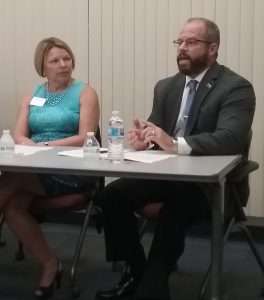Kane, Kendall school leaders talk funding, staff diversity
By Erika Wurst For Chronicle Media — September 25, 2017
From left, State Rep. Stephanie Kifowit, D-Oswego, Sarah Hartwick, co-director of legislative affairs for the Illinois State Board of Education; Dr. Mark McDonald, East Aurora School District 131; Dr. Karen Sullivan, Indian Prairie School District 204 and Dr. John Sparlin, Community School District 308, discuss with the public the top issues facing local school districts at the Aurora Public Library on Sept. 21. (Photo by Erika Wurst / for Chronicle Media)
School funding, technology in the classroom and the diversity of teaching staffs were all hot topics of discussion on as local school district superintendents gathered for a roundtable discussion at the Aurora Public Library on Sept. 21.
State Rep. Stephanie Kifowit, D-Oswego, invited superintendents Dr. Mark McDonald, East Aurora School District 131; Dr. Karen Sullivan, Indian Prairie School District 204; Dr. John Sparlin, Community School District 308; and Sarah Hartwick, co-director of legislative affairs for the Illinois State Board of Education, to address the public and hilight things happening in their districts and at the state level.
“Most property taxes go towards funding our local schools, so it’s important for homeowners to be engaged with school leadership,” Kifowit said. “My event will also give parents the chance to learn the latest updates about their children’s schools and ask questions.”
Hartwick, of the ISBE, spoke about funding changes on the state level that are expected to level the playing field for impoverished and underachieving school districts. She called the changes “monumentally historic” and said the state’s new evidence-based funding formula will help close the gap among local districts.
These funds, the superintendents agreed, are important to the functioning of their districts and the support of their students.
Despite recent funding snafus, each superintendent spoke of the strides and successes made in their districts.
In CUSD 308, composite ACT scores among seniors are the highest they’ve ever been, and newly administered SAT scores are above the state and national averages, Sparlin boasted.

Dr. Karen Sullivan, superintendent of Indian Prairie School District 204, listens as Dr. John Sparlin, superintendent of Community School District 308, addresses a question at public meet and greet with Kane and Kendall school leaders organized by State Rep. Stephanie Kifowit, D-Oswego at the Aurora Public Library on Sept. 21. (Photo by Erika Wurst / for Chronicle Media)
In District 131, which will benefit from seeing the most evidence-based funding dollars, there have also been recent successes, McDonald said.
There has been new construction and the implementation of new curriculum. The district has introduced bussing for the first time and despite financial woes, the district has a large fund balance to rest on, McDonald said.
And while the superintendents spoke of their successes, Kifowit raised a question that is on the minds of many residents.
“One of the things I hear as a representative is this misnomer of how teachers are less in number and administrators are more in number. People think the districts are these top-heavy institutions and not enough money is going to instruction. I hear this a lot in our communities and think it’s a good topic to discuss,” she said.
The panel was quick to point out that this thinking is not the reality in the local districts.
“In Indian Prairie there are more students per administrator than almost every school district in the state of Illinois. Out of 852 districts, only 12 had a better ratio than ours and those were mostly downstate districts that were very small,” Sullivan said.
She said the district has cut millions of dollars and is doing more with less every year.
McDonald agreed, saying that most school boards look to cut costs by reducing administrative staff, but must also be aware of the importance of having solid administrators at the helm.
“If there’s not enough administration, it could cost the schools more money. People are unsupervised and not managed property, ” he said.
“There is a fine balance,” Dr. Sparlin of 308 said. “Unfortunately we’re facing a deficit and had to make cuts. Those cuts have been to administration. In the past year we had to cut 20 percent of our district office.”
And while the districts are looking to lower administrative costs, they are each seeking to fill teaching positions and to diversify their staffs.
Aurora 9th Ward Alderman Ed Bugg asked each administrator what their districts are doing now so that the growing minority student bodies are represented by the teachers that serve them.
“I don’t know any district that isn’t facing this issue,” Sullivan said of the lack of minority teachers entering the workplace. “It’s very frustrating not seeing a pipeline of minority candidates go into teaching positions. We’re all competing for the same tiny pool of candidates.”
She said these days teachers aren’t as appreciated and that there seems to be fewer students entering the teaching profession.
Those who do enter the profession have a new host of challenges teachers 10 years ago didn’t have to face.
“Technology has changed everything,” Sullivan said. “We can’t ignore that with our students. We need to change with them, otherwise we’ll leave a whole generation behind.”
—- Kane, Kendall school leaders talk funding, staff diversity —



